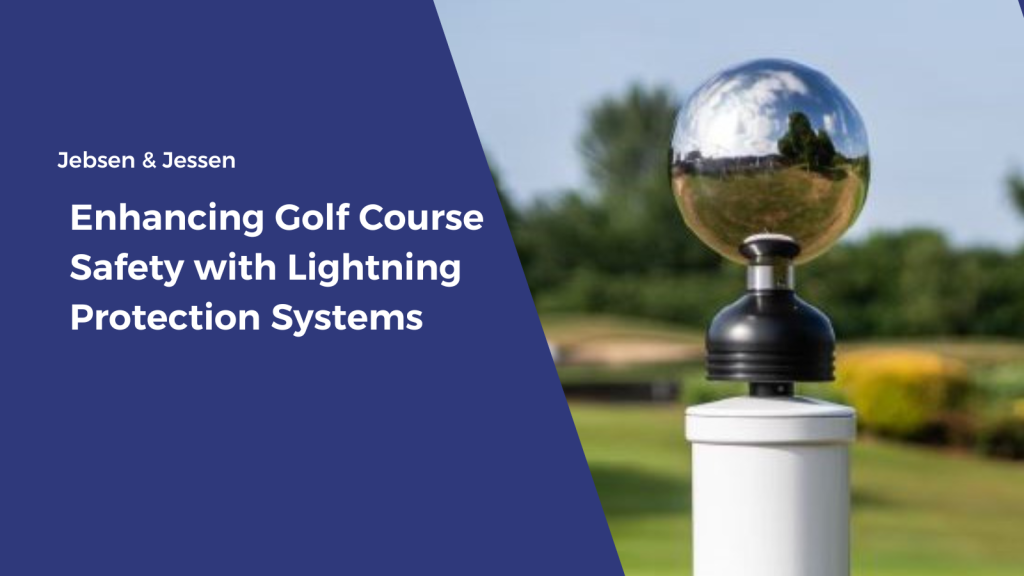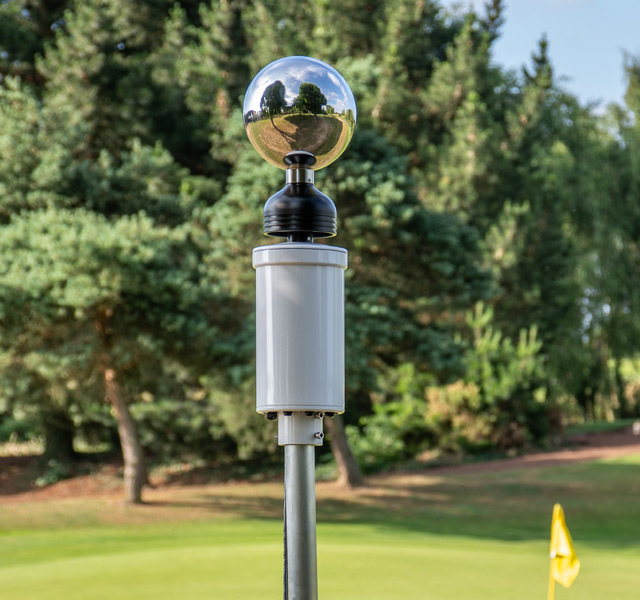Lightning strikes the earth over 8 million times a day. Recently, lightning struck a golf course in Delhi, etching a zigzag pattern on one of the trees and pausing the play. Incidents like this highlight the importance of robust lightning protection for golf facilities, especially in Southeast Asia’s tropical climate, where thunderstorms are frequent and intense. Advanced lightning protection systems allow golf courses to mitigate safety risks and prevent disruptions from volatile weather. With the strategic installation of lightning rods, surge protectors, and smart monitoring technology, golf clubs in Southeast Asia can safeguard golfers and operations when threatening skies approach.
While no system can offer 100% lightning protection, the right solutions can greatly reduce the risk of injury, death, and costly damage related to lightning and its side effects.
Understanding the Risks of Lightning on Golf Courses
Lightning is one of the leading weather-related causes of injury and death each year. In Southeast Asia, thunderstorms are frequent, especially during monsoon season. Even when skies appear calm and clear, fast-forming storms can roll in and catch golfers out on open courses.
Unlike other structures, golf courses offer virtually no shelter when lightning strikes. Tall trees, open spaces, bodies of water, and raised golf carts all increase the odds of a lightning casualty occurring. When lightning hits a tree, the current can hop along the ground, electrocuting anyone nearby. A lightning bolt can heat the air it passes through to 50,000°F, causing violent expansion and deadly electrical currents.
Direct lightning strikes account for only around 10% of lightning-related injuries. The more common cause of injury or death is ground current—electricity that radiates outward along the earth’s surface after a lightning bolt hits the ground.
Nearly half of golf lightning deaths involve the victim trying to take shelter under a tree, which is extremely dangerous as lightning spreads ground current outward when it strikes tall objects.
Ground current affects substantial areas around the lightning strike site and can electrocute multiple victims simultaneously. People standing outside on golf courses are extremely vulnerable to the ground current’s electrical jolt.
Risks to Infrastructure
Beyond the obvious risk of electrocution, lightning also threatens golf course infrastructure and property. A direct lightning strike can destroy irrigation controllers, damage underground wiring, and cause clubhouse fires. Following a nearby strike, the power surge may harm electrical equipment like pumps, computers, and smart sprinkler systems. Structural damage to buildings and even greens is also possible.
For golf facilities in Southeast Asia faced with frequent lightning storms, comprehensive protection is a prudent investment in safety, asset security, and business continuity. Let’s explore how modern lightning protection systems can mitigate these risks.
An Introduction to Lightning Protection Systems
Lightning protection systems are fail-safe mechanisms designed to shield buildings, golf courses, and open spaces from the damaging effects of lightning strikes. They work by intercepting lightning strikes and providing a safe path for the electric current to travel into the ground. The systems contain three key components:
Air Terminals
Also known as lightning rods, air terminals are mounted on the roof or at strategic points of the structure. The terminals act as a receptor, attracting any lightning strikes directly to them instead of other parts of the building.
Down Conductors
These thick copper wires connect the air terminals to the grounding system. When lightning hits the rod, the down conductor safely transfers the high voltage into the ground.
Grounding System
Underground conductive materials like concrete-encased electrodes and deep earth grounding rods provide a low resistance path for electricity to dissipate into the earth. This grounding system is vital for dispersing lightning currents.
Additional devices like lightning surge protectors and arc flash switches complement the primary components. Surge protectors shield electronic equipment from power spikes, while arc flash switches activate during a lightning event to isolate sections of wiring.
Common types of protection systems include Franklin rod systems, Faraday cage systems, and early streamer emission systems. The optimal setup depends on factors like the structure layout, ground composition, and risk assessment. For golf courses, strategically installed standalone lightning masts across the property may offer comprehensive protection.
The Benefits of Installing Lightning Protection
Constructing an adequate lightning protection system requires an initial investment. However, the potential rewards in risk mitigation make it well worth the cost for golf facilities in storm-prone regions. Benefits of properly installed lightning protection include:
- Increased Safety: Lightning protection systems greatly minimize the risk of injury or death. By channeling electrical discharges directly into the ground, the systems prevent contact between people and deadly electrical currents.
Advanced warning technology like the Biral BTD-200 Lightning Warning System can further amplify safety. With a 35 km detection range, this system provides local monitoring to capture all lightning threats approaching the golf course. The intuitive setup enables general contractors to handle installation while built-in automation sends proactive alerts of inclement weather. Early warnings from systems like the BTD-200 give facilities more time to enact protective measures before lightning strikes. - Reduced Property Damage: Building structures, electronic equipment, and other assets are shielded from destruction in the case of a direct lightning strike or power surge. Maintenance and repair costs are significantly lowered.
- Less Downtime: With lightning protection in place, facilities can resume normal operations almost immediately after a storm passes. There is no need for prolonged closure due to equipment damage or electrical repairs.
- Insurance Benefits: Some insurers offer premium discounts to policyholders with installed lightning protection systems. Risk reduction also makes it easier to obtain insurance coverage.
- Golfer Confidence: Golfers who know management prioritizes their safety and experience during storms will have greater trust and satisfaction. Peace of mind improves the golfing experience.
Technological Advancements in Lightning Safety
In recent years, intelligent technology integrations have amplified the capabilities of lightning protection systems. Monitoring and automation capabilities allow golf courses to take proactive actions and heighten responsiveness when threatening weather approaches.
- Remote Monitoring: Advanced systems incorporate real-time weather data through connected devices like anemometers and electric field mills. Course personnel can monitor conditions from anywhere and receive automated alerts.
- Integration with Other Systems: Modern solutions sync with fire alarms, emergency lighting, automated defibrillators, and other safety systems. This integration enables intelligent emergency response during a lightning event.
- Damage Prevention: Smart systems can interface with key infrastructure to help prevent lightning damage from occurring in the first place. For example, automated controls can shut off irrigation systems or pool pumps when lightning is detected nearby.
- Data Insights: The latest systems come with sophisticated data analytics to identify usage and performance trends. These insights allow for data-driven enhancements and customizations.
- Ease of Use: User-friendly control panels and mobile apps make lightning protection systems simple to operate and monitor without extensive training.
- Guidance and Support: Reputable solutions providers offer specialized guidance to help courses select, install, and manage the optimal system design for their facilities.
By embracing these technological advances, golf courses can achieve much higher levels of lightning protection. Integrating intelligent systems into existing infrastructure requires working with experienced safety solutions experts.
Lightning Protection Success Story: Tanah Merah Country Club, Singapore
Tanah Merah Country Club (TMCC) is a premier golf resort situated along Singapore’s east coast. The club features two championship golf courses, the Garden Course and the Tampines Course. Both layouts present golfers with beautiful parkland scenery, undulating terrain, and placid lakes.
However, TMCC’s tranquil setting belies the heavy thunderstorms it frequently contends with. The region endures over 170 thunder days annually. Lightning had damaged course infrastructure, disrupted play, and raised safety concerns among golfers and staff.
In 2009, a businessman was struck by lightning and killed while playing golf at the Tanah Merah Country Club in Singapore. His family sued the club for negligence.
- The victim was 57-year-old Soh Lye Huat
- Struck by lightning on October 25, 2009
- Died two weeks later from organ failure
- The club settled, agreeing to pay $64,246 in damages plus legal costs
- First known case of a Singapore golf club being sued over a lightning death
- Singapore has one of the highest rates of lightning activity globally
The case highlighted the need for proper emergency procedures and safety precautions related to lightning at golf courses in Southeast Asia.
So, the club deployed a comprehensive lightning protection system across its two courses.
The extensive network consists of 25 freestanding lightning masts standing 20 meters tall and spaced 150 meters apart. The masts are connected via a grid of underground copper cables that direct current into the ground. TMCC also installed in-ground copper mesh shields under each green, surge protection equipment, and a connected weather station and mobile app.
Since activating the system, Tanah Merah Country Club has enjoyed an uneventful storm season. The technology provides golfers, staff, and the club peace of mind.
Choosing the Right Lightning Protection for Your Golf Course
Installing lightning protection is a complex undertaking requiring careful planning and execution. However, the rewards merit the initial time and financial investment. As you assess options for your golf facility, keep these key considerations in mind:
- Risk Profile: Consider your specific risk factors like location, terrain, tree cover, and storm patterns. A lightning risk assessment can inform the scope of protection needed.
- Course Layout: Larger golf courses may require more air terminals and down conductors to ensure full coverage. Account for all structures and activity zones.
- Local Standards: Verify your planned system meets all electrical and construction safety codes for your area. Some locations mandate certain requirements.
- Ease of Maintenance: Opt for durable, low-maintenance materials and placements that minimize interference with course operations and landscaping.
- Budget: Lightning protection system costs vary based on size and complexity. Prioritize key structures and high-traffic areas if full coverage exceeds your budget.
- Future Expandability: Pick a modular system that allows for easy expansion as needs evolve. You can add components over time.
- Expert Guidance: Consult qualified specialists to tailor the optimal system design for your golf course’s unique needs and budget.
Staying Safe When the Thunder Roars
Lightning poses a serious threat to the safety of golfers and the continuity of golf course operations across Southeast Asia’s storm-prone climate. However, advanced lightning protection systems provide a proactive defense against volatile weather.
Strategic installation of lightning rods, grounding systems, and smart weather monitoring devices can greatly reduce the risk of lightning incidents. These solutions channel electrical discharges away from people while protecting infrastructure from surges and damage.
Cutting-edge technology integrations even enable intelligent emergency response and early weather warnings to maximize safety. While no system offers 100% protection, proper lightning safeguards can dramatically mitigate risks.
Golf course managers concerned about tropical thunderstorms disrupting play, endangering golfers, and damaging facilities should consult qualified specialists. The lightning protection experts at Jebsen & Jessen can conduct on-site assessments and recommend tailored solutions for your golf course’s unique needs and budget.
By implementing a customized lightning protection strategy, golf clubs across Southeast Asia can safeguard their Greens when storms strike. Don’t leave safety to chance. Contact our team today to address the lightning hazard proactively.




